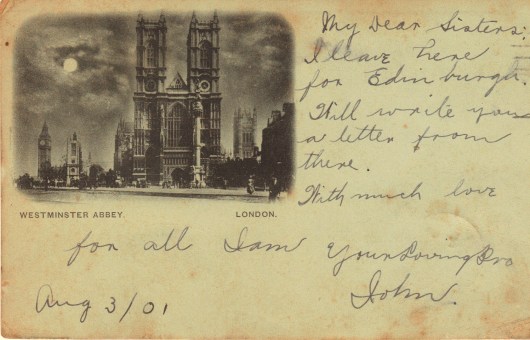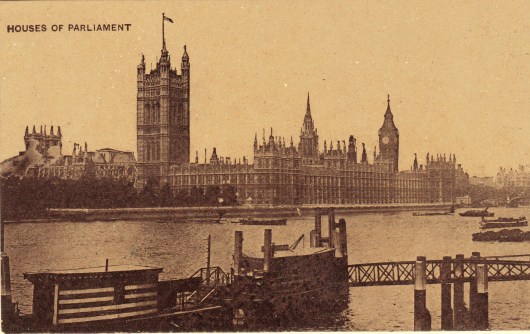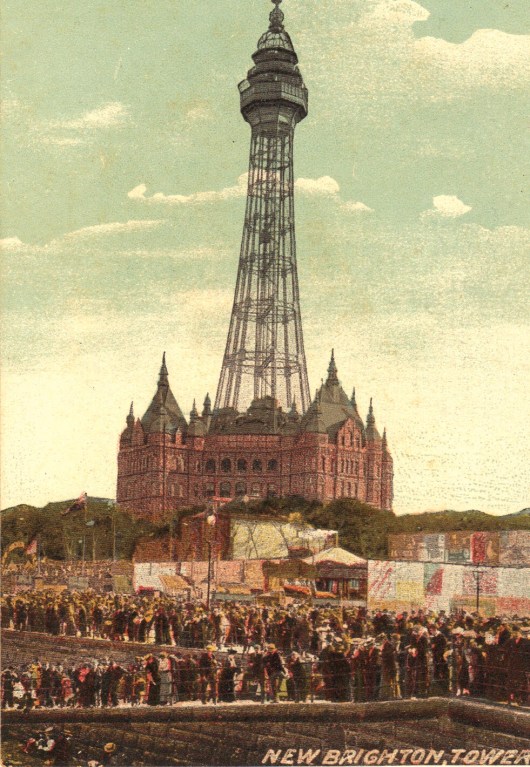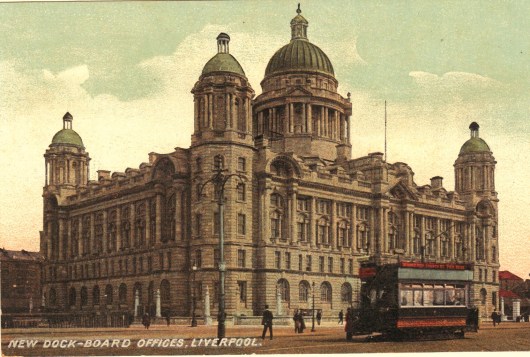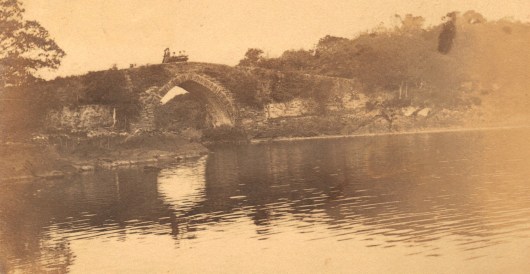Wrapping up our tour of England this week we are returning to our primary source material – Margaret Edythe Young’s album – and find a post card dated August 3, 1901 from her brother John addressed to Misses Edythe and Laureene Young at 3324 Avenue L, Galveston, Texas. It has an almost superfluous scene of Westminster Abbey since its real intent is simply to drop a line and let the folks at home know where you are. The real account of what is going on will follow in the letter where greater details may be given and the prying eyes of the house may be guarded against scandal.
The only other card from London is a panorama of the Houses of Parliament. What today’s reader may not fully grasp is that the buildings were as new and as marvelous for the tourists as the Millennium Dome would be a century later. Without quite the entertainment value of the London Eye it still drew crowds to watch the quaint peers mete out just and unjust laws to a savage race and listen to the tolling of Big Ben.
I am his majesty’s dog at Kew, Pray tell me whose dog are you? was a bit of doggerel inscribed on a tag for one of the dogs at Kew Gardens that are also now known as the Royal Botanic Gardens. They date their foundation from 1759 and the Pagoda was constructed in 1761. The pagoda was designed by William Chambers, a Scotsman who was born in Gothenburg, Sweden, where his father was a merchant. Between 1740 and 1749 he was employed by the Swedish East India Company making three voyages to China where he studied Chinese architecture and decoration. Through a recommendation he was appointed architectural tutor to the Prince of Wales, later George III, and he worked for Augusta, Dowager Princess of Wales making fanciful garden buildings at Kew and publishing a book of Chinese designs which were widely copied. Covering hundreds of acres and incorporating nearly 30,000 species of plants as well as a minor palace [appropriately enough the royal nursery] and an abundance of unique architecture including The Temperate House – a greenhouse, the world’s largest surviving Victorian glass structure commissioned in 1859 which covering nearly 50 acres it rises to a height of over 60 feet the Gardens would be as thoroughly observed as the museums.
London may have been the center of England much as Rome is the center of Italy but there were other places to go and other things to see. Italy has Florence and Venice and to a much lesser degree England has Glasgow and Liverpool. Liverpool would have been of particular interest to the Young family because of the maritime connection and because it was the main port where the Irish came and went between the two islands. America had its love affair with skyscrapers – in many ways vertical factories – while Europe gave up the dreaming spires of Oxford and the soaring vaulted domes of cathedrals for the relatively pedestrian wedding of steel and tourism and threw up towers seeking to create the new Babel, at a profit.
In 1889 the French had opened the Eiffel Tower as the entrance arch to the World’s Fair. Seeking to capitalize on their success in 1894 London opened its Blackpool Tower and in 1900 Liverpool opened the New Brighton Tower. Although similar in design and intent neither of the English towers ever approached the importance of the original in terms of cultural status or financial success. The singular distinction of the New Brighton Tower is as a musical footnote. In 1897 Granville Bantock, a young conductor, was appointed and given a full orchestra. The proprietors wanted him to give mainly light music concerts for the tourists. Bantock, finding himself in charge of a full orchestra decided the content did not have to cater for popular tastes and he embarked on advanced concerts of the new composers, as well as his own works. He was also conductor of the Liverpool Orchestral Society with which he premiered Delius’s Brigg Fair and perhaps most importantly he premiered in the UK works of Richard Strauss and Jean Sibelius who dedicated his third symphony to him. While I find no notes about his music in any of the correspondence it could not have been any worse than Little Richard or the Beatles both of whom played the Blackpool venue.
During the latter half of the 19th century Liverpool became Britain’s No 1 port for passengers wishing to travel to America, and the shipping and commerce of the Mersey were exceeded only by those of the Thames with its Ports of London and Tilbury. Liverpool’s position was threatened in the 1890s after the London & South Western Railway purchased Southampton Docks in 1892 and initiated substantial improvements offering a quick turn-round for ships – which are very expensive and earn no money when they are idle and not at sea. Although this was exactly the opposite of the situation in the competition between Galveston and Houston, Galveston had one thing in common with Liverpool in that both dock companies were run by private investors.
In 1858 the Liverpool Corporation would divest its dock interests to a new public body as a result of pressure from parliament, dock merchants and some rival port operators – just as the Port of Galveston would eventually take over from the Galveston Wharf Board after the Port of Houston had been built with tax dollars that were not available for Galveston since it paid a dividend to private investors. As a lesson for the learning it must be noted that in the case of Liverpool in 1972 the Board was reconstituted as a company to allow it to raise money for new building initiatives and projects – maybe the market works best after all. The New Dock Board offices pictured above still exist and still serve as the offices for the Port of Liverpool.
Nec Aspera Terrent (Difficulties be Damned)is a more than justifiable motto for the King’s Regiment (Liverpool). In one form or another its history ranges from 1685 until 1958 when England said farewell to its regiments in favor of putting everything under the control of modern major generals. During the late nineteenth century one battalion of the regiment would do more than its fair share of fighting and dying in Burma and at the turn of the century the other battalion would endure Mournful Monday, the Siege of Ladysmith and the Black Week of December during the Boer War.
While John Young, the elder, might have ambitions to gaining social acceptance by publicly assuming the role of an “English” gentleman at home in Galveston the record shows that he was as much a great supporter of Parnell and the advocates of Irish freedom when it came to concrete actions. Other members of the family, notably the brothers Coffey, were more emphatically Irish and the Galveston Daily News recounts them having found and displayed prominently a Boer flag for the New Year’s Day celebrations.
We say goodby to England from the little town of Redditch near Birmingham and have a note from a friend also involved in the cotton and shipping business; We are glad to hear that you had all safely arrived home again [Galveston]. We have almost finished our wanderings also; the only remaining part being the return to South Africa. I start back on January 4, Mrs. B. is remaining until June or July. We had fairly good weather all round, but not equal to Ireland. We had our first snow for eight years in Germany… Next, on to the Continent!
